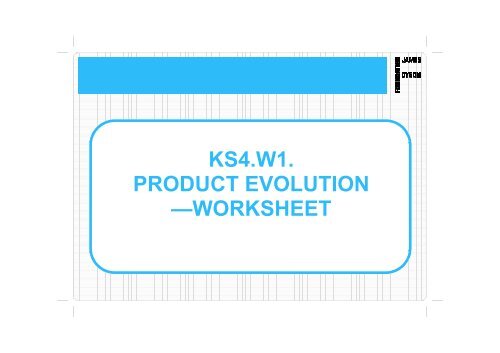KS4.W1. Product evolution - worksheet - National STEM Centre
KS4.W1. Product evolution - worksheet - National STEM Centre
KS4.W1. Product evolution - worksheet - National STEM Centre
Create successful ePaper yourself
Turn your PDF publications into a flip-book with our unique Google optimized e-Paper software.
<strong>KS4.W1.</strong><br />
PRODUCT EVOLUTION<br />
—WORKSHEET
PRODUCT EVOLUTION<br />
LIST THE PRODUCTS IN ORDER - WHICH WAS DESIGNED<br />
FIRST?<br />
THINK ABOUT:<br />
• How has the product and idea changed?<br />
• Why has the design changed at all? Discuss your answers.<br />
• What problems have the designers tried to solve?<br />
• What new parts and components can you see?
�<br />
<strong>KS4.W1.</strong> PRODUCT EVOLUTION <strong>KS4.W1.</strong> PRODUCT EVOLUTION<br />
- - - - - - - - - - - - - - - - - - - - - - - - - - - - - - - - - - - - - - - - - - - - - -
�<br />
<strong>KS4.W1.</strong> PRODUCT EVOLUTION <strong>KS4.W1.</strong> PRODUCT EVOLUTION<br />
- - - - - - - - - - - - - - - - - - - - - - - - - - - - - - - - - - - - - - - - - - - - - -
�<br />
<strong>KS4.W1.</strong> PRODUCT EVOLUTION <strong>KS4.W1.</strong> PRODUCT EVOLUTION<br />
- - - - - - - - - - - - - - - - - - - - - - - - - - - - - - - - - - - - - - - - - - - - - -
<strong>KS4.W1.</strong><br />
PRODUCT EVOLUTION<br />
— WORKSHEET<br />
TEACHER’S COPY
<strong>KS4.W1.</strong> PRODUCT EVOLUTION<br />
<strong>Product</strong>s evolve as new technology and materials are developed. Look at the five computer designs below.<br />
INSTRUCTIONS FOR TEACHERS:<br />
Ask the students to take one of the <strong>KS4.W1.</strong> <strong>Product</strong> <strong>evolution</strong>—<strong>worksheet</strong> files per group. Encourage them to look at the<br />
products and work out the order they were designed. Why do they think this is? They can use the boxes provided to record their<br />
answers and discuss in groups.<br />
AN EXAMPLE - COMPUTER EVOLUTION:
<strong>KS4.W1.</strong> PRODUCT EVOLUTION<br />
GRAMOPHONE, 1886<br />
Early attempts to invent a commercial sound system began<br />
with Thomas Edison’s Phonograph in 1877. It used round<br />
cylinders coated in perforated tin foil, but the sound quality was<br />
poor (and the recording could only be played once). In 1886<br />
Emile Berliner started experimenting with flat discs made from<br />
various materials (including glass). Sound information was<br />
scored onto the disc’s surface, which in turn would be read by<br />
a stylus or needle attached to the gramophone itself.<br />
Vibrations caused by the needle’s contact with the disc<br />
transferred to a large cone, which amplified the sound. The<br />
gramophone soon became the first mass-produced sound<br />
system.<br />
TRANSISTOR RADIO, 1947<br />
The broadcast of radio was nothing new in the 1940’s. But how it<br />
was received and consumed was about to change altogether. In<br />
1947 the transistor was developed. It replaced the vacuum tube<br />
amplifiers used in existing radios, allowing a signal to be received<br />
with much less power. It meant that physically, the radio could be<br />
much smaller and lighter. It also meant the radio could be<br />
battery-powered – listening was no longer confined to the home.
<strong>KS4.W1.</strong> PRODUCT EVOLUTION<br />
SONY DISCMAN D-50, 1984<br />
By the mid-80s, the compact disc started to replace<br />
cassette tapes. People expected to use them in the<br />
same way – in the car, on a stereo and (as with the<br />
Walkman) on the move. The Discman held the<br />
same principles as its predecessor – the device was<br />
slightly larger than the media it played (in this case,<br />
discs). It meant that digital quality playback was<br />
possible anywhere.<br />
SONY WALKMAN TPS-L2, 1979<br />
Sony developed the first truly portable music system –<br />
the TPS-L2 Walkman cassette player. The Walkman’s<br />
real innovation was its size, measuring only slightly<br />
larger than a cassette tape itself. It also featured a pair<br />
of portable, lightweight headphones and operated on AA<br />
batteries. The Sony Walkman became a design icon<br />
and went on to sell millions of units.
<strong>KS4.W1.</strong> PRODUCT EVOLUTION<br />
DIGITAL AUDIO PLAYERS, 1998<br />
Finding a commercial outlet for digital audio has taken some time. In 1979,<br />
a digital audio prototype was developed by American, Kane Kramer – it was<br />
a simple design capable of 3.5 minutes playback. Despite filing for (and<br />
eventually receiving) patent protection in the late 1980s, the design was<br />
never released. It wasn’t until 1996 that a more practical use for digital<br />
audio was invented: Audio Highway developed a system to store music on<br />
a PC using MP3. It let the user transfer music from CD into MP3 format on<br />
a PC, the subsequently to the MP3 player. As the technology was<br />
developed flash memory increased as did better design features. Next<br />
came the installation of laptop hard drives for a massive increase in<br />
capacity, helping the popularity of the digital audio player.<br />
APPLE iPod, 2001<br />
The original iPod was released in 2001, combining a 5GB<br />
hard drive with a rechargeable battery pack. It also employed<br />
an easy to use interface that still dominates the portable<br />
music player market. The iPod design has evolved – smaller<br />
shapes, larger capacity; improvement of battery life and<br />
usability. Also the addition of games, video and photographs.<br />
More recently the iPod Touch gives Internet access and the<br />
ability to download films, games and other applications.

















